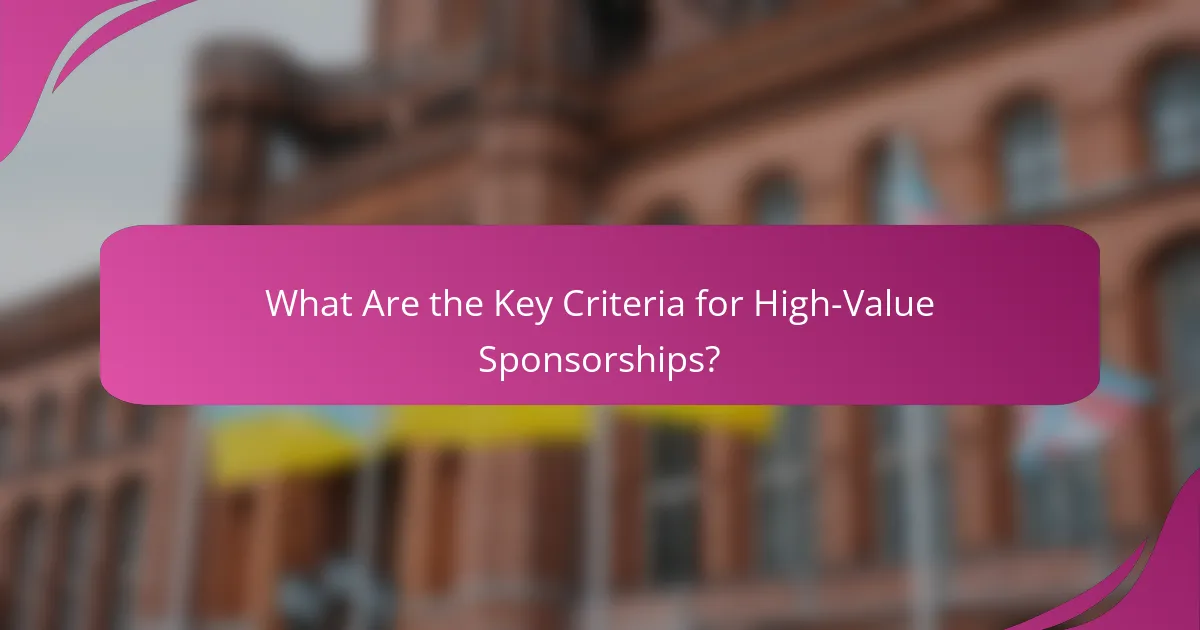High-value sponsorships are essential for creating mutually beneficial relationships between brands and sponsored entities, characterized by criteria such as alignment with brand values and audience compatibility. These partnerships provide significant advantages, including increased visibility and access to new markets, ultimately driving brand recognition and customer engagement. To maximize these benefits, it is crucial to develop effective strategies that align your goals with those of potential partners.

What Are the Key Criteria for High-Value Sponsorships?
High-value sponsorships are defined by several key criteria that ensure mutual benefit for both the sponsor and the sponsored entity. These criteria include alignment with brand values, compatibility with the target audience, potential for engagement, measurable outcomes, and budget considerations.
Alignment with brand values
For a sponsorship to be effective, it must align with the core values of the sponsoring brand. This alignment fosters authenticity and strengthens brand identity, making it easier for consumers to connect with both the sponsor and the sponsored entity.
Brands should evaluate potential sponsorships by assessing how well the values of the event or organization resonate with their own. For example, a company focused on sustainability should consider sponsoring eco-friendly events or organizations.
Target audience compatibility
Understanding the target audience is crucial for high-value sponsorships. The demographics and interests of the audience should match those of the sponsor’s customer base to maximize impact and engagement.
Brands can analyze audience data from the sponsored entity to ensure compatibility. For instance, if a tech company sponsors a gaming tournament, they should confirm that the majority of attendees are within their target age group and show interest in technology.
Potential for engagement
High-value sponsorships should offer opportunities for meaningful engagement with the audience. This can include interactive experiences, product demonstrations, or exclusive content that encourages participation.
Brands should consider how they can leverage the sponsorship to create memorable interactions. For example, hosting a booth at an event where attendees can try products or participate in contests can enhance engagement and brand recall.
Measurable outcomes
Establishing measurable outcomes is essential for evaluating the success of a sponsorship. Brands should define key performance indicators (KPIs) such as brand awareness, lead generation, or sales conversions before entering into a sponsorship agreement.
Using tools like surveys, social media analytics, and sales tracking can help assess the effectiveness of the sponsorship. Setting clear goals allows brands to determine whether the investment was worthwhile and to refine future sponsorship strategies.
Budget considerations
Budget is a critical factor in determining the feasibility of a sponsorship. Brands need to assess not only the sponsorship fee but also additional costs such as activation, promotional materials, and travel expenses.
It’s advisable to allocate a budget that reflects the expected return on investment. Brands should avoid overspending on sponsorships that do not align with their goals or audience, ensuring that every dollar spent contributes to their overall marketing strategy.

What Benefits Do High-Value Sponsorships Provide?
High-value sponsorships offer significant advantages, including increased brand visibility, enhanced credibility, access to new markets, and valuable networking opportunities. These benefits can lead to improved brand recognition and growth in customer engagement.
Increased brand visibility
High-value sponsorships significantly boost brand visibility by placing your logo and messaging in front of a larger audience. This exposure often occurs at high-profile events, media campaigns, or through digital platforms associated with the sponsorship.
Consider sponsoring a major sports event or cultural festival, where your brand can reach thousands of attendees and millions of viewers. This kind of visibility can translate into increased brand awareness and customer interest.
Enhanced credibility
Aligning your brand with reputable organizations or events enhances your credibility in the eyes of consumers. When a well-respected entity endorses your brand through sponsorship, it signals trust and quality to potential customers.
For example, sponsoring a charity event can improve your brand’s image by showcasing your commitment to social responsibility, which resonates well with consumers who value ethical practices.
Access to new markets
High-value sponsorships can open doors to new markets by introducing your brand to diverse audiences. This is particularly effective when sponsoring events that attract different demographics or geographic regions.
For instance, sponsoring an international conference can help you reach potential customers in various countries, expanding your market reach and increasing sales opportunities.
Networking opportunities
Sponsorships provide unique networking opportunities with industry leaders, potential partners, and influencers. Engaging with other sponsors and attendees can lead to valuable business connections and collaborations.
Participating in exclusive sponsor events or VIP gatherings allows you to build relationships that can lead to future business ventures or partnerships, enhancing your brand’s influence in the industry.

How to Develop Effective Sponsorship Strategies?
To develop effective sponsorship strategies, focus on aligning your goals with potential partners’ objectives. A well-structured approach enhances the chances of securing valuable sponsorships that benefit both parties.
Identify target partners
Identifying target partners is crucial for successful sponsorship strategies. Look for brands that share similar values, target demographics, or market goals. Research potential sponsors in your industry or related sectors to find those that would resonate with your audience.
Consider factors such as the sponsor’s reputation, past sponsorship activities, and their current marketing objectives. This helps ensure a mutually beneficial partnership that can enhance brand visibility and engagement.
Create tailored proposals
Creating tailored proposals is essential to capture the interest of potential sponsors. Each proposal should address the specific needs and goals of the partner, highlighting how the sponsorship aligns with their marketing strategy.
Include details about your audience demographics, engagement metrics, and the unique benefits they will receive. Use visuals and data to support your claims, making it easier for sponsors to see the value of the partnership.
Leverage digital marketing
Leveraging digital marketing can significantly enhance the effectiveness of your sponsorship strategies. Utilize social media platforms, email marketing, and content marketing to promote the partnership and reach a wider audience.
Consider creating co-branded content or campaigns that highlight the sponsor’s involvement. This not only increases visibility but also fosters a sense of collaboration that can attract more sponsors in the future.
Measure and analyze results
Measuring and analyzing results is vital to understanding the effectiveness of your sponsorship strategies. Track key performance indicators (KPIs) such as engagement rates, website traffic, and conversion rates to assess the impact of the sponsorship.
Regularly review these metrics and gather feedback from sponsors to identify areas for improvement. This data-driven approach allows you to refine future strategies and demonstrate the value of sponsorships to potential partners.

What Are the Best Practices for Evaluating Sponsorship Opportunities?
Evaluating sponsorship opportunities effectively involves a systematic approach to ensure alignment with your brand’s goals and values. Key practices include conducting thorough market research and assessing the performance of past sponsorships to make informed decisions.
Conduct market research
Market research is essential for understanding the landscape of potential sponsorships. This includes identifying target demographics, analyzing competitors, and evaluating the overall market trends relevant to your industry. Utilize surveys, focus groups, and industry reports to gather insights.
Consider the reach and engagement of the potential sponsor’s audience. Look for opportunities that align with your brand’s values and resonate with your target market. For example, if your brand focuses on sustainability, partnering with eco-friendly events or organizations could enhance your credibility.
Assess past sponsorship performance
Reviewing the performance of previous sponsorships can provide valuable insights into what works and what doesn’t. Analyze metrics such as brand visibility, audience engagement, and return on investment (ROI) from past partnerships. This data can help you set realistic expectations for future sponsorships.
When assessing past performance, consider both qualitative and quantitative results. For instance, did the sponsorship enhance brand reputation or increase sales? A successful sponsorship should ideally show a positive impact on your brand’s objectives, whether through increased market share or improved customer loyalty.
